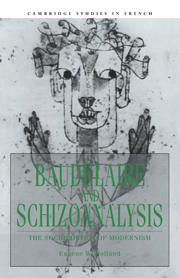2 - Correspondences versus beauty
Published online by Cambridge University Press: 22 August 2009
Summary
THE ROMANTIC CYCLE
“Correspondances” (IV) has traditionally been hailed as the centerpiece of Les Fleurs du Mal and the most direct expression of the Baudelairean aesthetic. According to the standard interpretations, this sonnet presents with “remarkable clarity and brilliance” the “eternal formulae” of romantic symbolism: the absolute intelligibility of the sensible world, the hidden unity of humankind and nature which it is the poet's privilege to decipher and represent. But romanticism was a stance Baudelaire came to regard with suspicion, even disdain. Far from being the key to Les Fleurs du Mal, “Correspondances” epitomizes an aesthetic that the rest of the collection will work to undermine and ultimately to reject. Alongside or beneath whatever thematic structure the work may have, the process of decoding in Baudelaire's work leads away from the romantic poetics of “universal analogy” so exquisitely formulated in “Correspondances” toward a modernist poetics that will predominate from Les Fleurs du Mal to the Petits Poëmes en prose, and which first appears in the pivotal sonnet entitled “La Beauté” (XVII).
“Correspondances” figures in an introductory group of poems (the prefatory “Au lecteur” apart) that reiterate the romantic topos of the misunderstood artist reviled by a philistine society (starting with “Bénédiction” [I]).
- Type
- Chapter
- Information
- Baudelaire and SchizoanalysisThe Socio-Poetics of Modernism, pp. 43 - 79Publisher: Cambridge University PressPrint publication year: 1993

